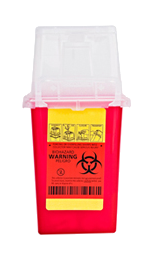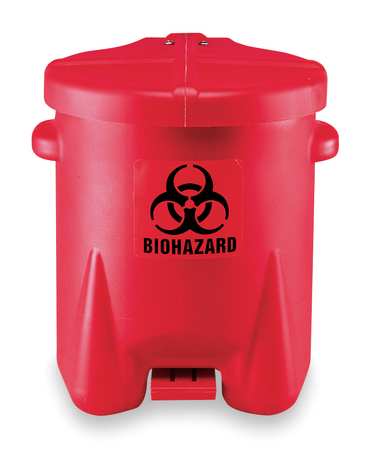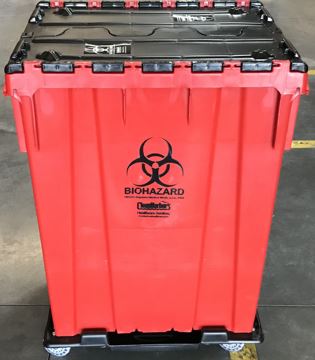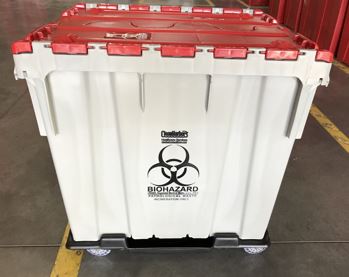Biohazardous Containers and Bags
Learn about the types of biohazardous waste containers and bags and how to manage them.
Biohazardous Sharps Containers
Commercial biohazardous sharps containers are used to collect devices or objects with corners, edges, or projections capable of cutting or piercing skin or regular waste bags, that have come into contact with biological or recombinant genetic materials. These containers must meet the standards of the United States Food and Drug Administration (FDA) and comprise of a container which is:
- Rigid
- Puncture-resistant
- Leak-resistant
- Equipped with a tight-fitting cover
- Labeled with the international biohazard symbol and the word “BIOHAZARD”
Biohazardous sharps containers may be purchased from the UC San Diego Chemistry & Biochemistry Stockroom or procurement (see Buyers Guide at the bottom of the page for an up-to-date catalog list of compliant containers) and must be labeled with UC San Diego identification information as follows:
Main Campus Location
- University of California, San Diego, 9500 Gilman Drive, La Jolla, CA 92093, (858) 534-4357
- Building name and room number where the waste was generated
- Campus Address Label Template (Word file)
Medical Center Location
- UC San Diego Medical Center, 200 West Arbor Drive, San Diego, CA 92103, (619) 543-6222
- Building name and room number where the waste was generated
- Medical Center Address Label Template (Word file)
Biohazardous sharps containers must be closed and secured once the sharps waste has reached the indicated “fill” line, followed by placement in an appropriate red biohazard waste container (see Biohazardous Waste Bins section below), and removal to the department’s designated biohazardous waste collection area for autoclaving, deactivation, or destruction. Do not mix chemical or radioactive sharps into biohazardous sharps containers. Other solid biohazardous waste must be disposed of in biohazardous waste bags as indicated below.
Purchasing Waste Bags
Obtain proper red biohazard waste bags. Purchase already pre-labeled bags using these services:
When purchased through the Stockroom or Core Bio Services, bags come pre-printed with UC San Diego identification labels in different sizes and quantities, complying with all other labeling requirements. Bags must be red in color and marked with the following:
- International Biohazard Symbol
- ASTM D1922
- ASTM D1709
Purchasing waste bags via procurement is acceptable; however, ensure that these bags have the American Society for Testing and Materials (ASTM) and biohazard symbol markings. For a list of approved bags, visit the Research Safety Buyer's Guide at the bottom of this page.
Labeling Bags with UC San Diego Identification Information
Two waste bags must be used when disposing of biohazardous waste. Label both bags — before waste is placed inside — with the following UC San Diego identification information:Main Campus location
- University of California San Diego, 9500 Gilman Drive, La Jolla, CA 92093, (858) 534-4357
- Building name and room number where the waste was generated
- Campus Address Label Template (Word file)
Medical Center location
- UC San Diego Medical Center, 200 West Arbor Drive, San Diego, CA 92103, (619) 543-6222
- Building name and room number where the waste was generated
- Medical Center Address Label Template (Word file)
Only use bags that meet ASTM standards e.g., has a biohazard symbol on it, text saying it "complies with ASTM D1922/D1709", etc. See Buying Guide for Labs section below.
Secondary Biomedical Waste Containers
When in use, biohazardous waste bags must be stored and transported in a secondary container. A secondary container can be any color and has to comply with the following:
- Rigid
- Leak-resistant

- Tight-fitting cover
Note: Wire-rack hangers are not an appropriate secondary container for biohazard waste bags in research labs.
Secondary containers must be labeled with the following:
- The words "Biohazard Waste"; or
- International biohazard symbol and the word "Biohazard"
Secondary containers must be free of visible contamination and disinfected after removal of biohazard waste bags:
- Exposure to hot water of at least 82° Centigrade (180° Fahrenheit) for a minimum of 15 seconds.
- Exposure to chemical sanitizer by rinsing with, or immersion in, one of the following for a minimum of three minutes:
- Hypochlorite solution (500 ppm available chlorine)
- Phenolic solution (500 ppm active agent)
- Iodoform solution (100 ppm available iodine)
- Quaternary ammonium solution (400 ppm active agent)
Secondary Biomedical Waste Bins Containers
At the bench, labs need a small, rigid, leak-resistant container with a lid and lined with a red biohazardous waste bag.
- The container must be labeled with biohazardous stickers on both sides and the lid.
- Wire-rack hangers are not appropriate.
- The small biohazardous waste bag will not require an address label or ASTM markings if it is tied and placed inside the larger biohazard waste container.
- When full, tie off the bag and dispose of it in large red biohazard bags.
- Following the disposal of the waste bag, decontaminate the inside of the reusable bio waste container with chemical sanitizer if not double bagged.
Biohazardous Waste Collection Bins
These bins have an attached hinged lid, are fitted with wheels, and labeled "BIOHAZARD". Biohazardous Waste Collection Bins come in two types: Red Biohazardous Waste Bin with Clamshell Lid and Grey Pathological Waste Bin with Clamshell Lid - for Vivarium use (See photos). 
How to use the Red Biohazardous Waste Collection Bins:
- Double red-bagged biohazardous waste that has been securely tied off and labeled with address, building and room# (see above for proper bag purchasing and labeling information).
- Full sharps containers that are properly labeled and sealed must be placed into the Red Biohazard Waste Collection Bin.
- See Biohazardous Waste Disposal Guidelines Poster for additional information
Prohibited Red Biohazardous Waste Collection Bin Items:
- No free-flowing liquids (sealed tubes of biohazardous liquids in small quantities are allowed)
- No carcasses (these must be disposed of in the Grey Pathological Waste Bins, see further Animal Carcass Disposal Guidance)
- No extremely hazardous chemicals or radioactive chemicals
- No mixed waste – items contaminated with more than 1 category of hazardous waste (biological + chemical or radioactive contamination)
- No loose sharps – Hypodermic needles, syringes with attached needles (or needleless plungers), scalpels, razor blades, and broken glass must be disposed of in a rigid, plastic sharps container. Only full, properly labeled, and sealed sharps containers can go in the Red BIOHAZARD Waste Collection Bins. See further Sharps Disposal Guidance.

Do not overfill bins!
Keep the lid closed when waste is not being added. Over-stuffed and unclosed Biowaste Bins violate County hazardous waste regulations (see photo). Full Biowaste Bins are collected for disposal by EH&S waste technicians. The bins are sanitized by a biohazard waste vendor, returned, and placed in service.
See the Hazardous Waste Menu for detailed packaging, labeling, container, storage and disposal requirements for these and all other categories of hazardous waste generated at UC San Diego.
How to transport
Transport tied-off bags and sealed sharps containers to the collection area using a rigid, leak-resistant secondary container with a tight-fitting lid (labeled as biohazard). Note: The person transporting is required to wear a lab coat, safety glasses and gloves. To prevent contamination spread, do not use gloved hands to open doors/push elevator buttons. If using a buddy system, one person is responsible for transport and one person is responsible for opening doors and operating the elevator. If one person is transporting, use one gloved hand and one ungloved hand. Bring extra gloves for the transfer of red bag/sharps to the final Biowaste Collection Bin.
Buying Guide for Labs
Find approved biohazard bags, sharps containers, plastic pasteur pipets and needles for your lab. The Research Safety Buyer's Guide is updated with products that meet ASTM standards. A safe, well-managed laboratory requires appropriate safety equipment for each type of discipline. When determining your needs, consider the hazards lab personnel will routinely encounter. Remember that these items need to be in serviceable condition and in adequate quantities for the number and managed correctly. Continually inspect your lab and monitor your inventory.